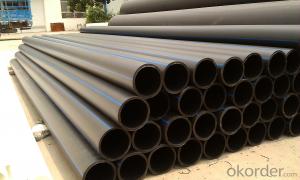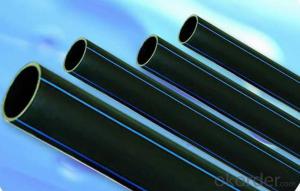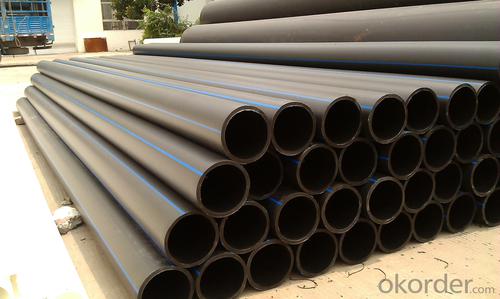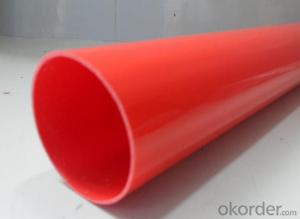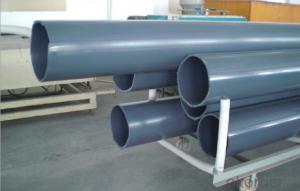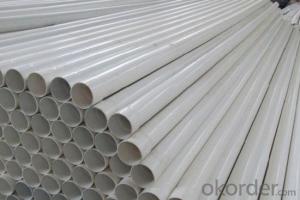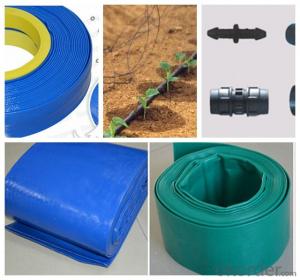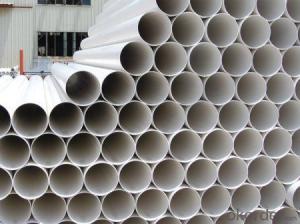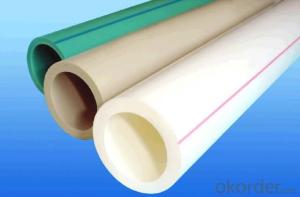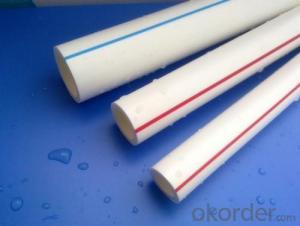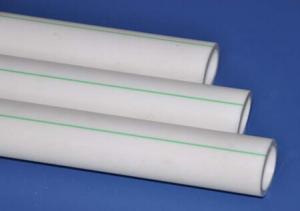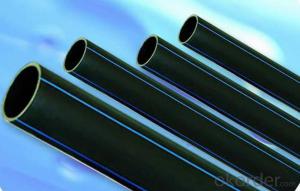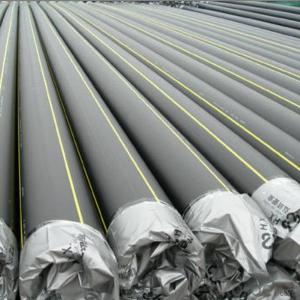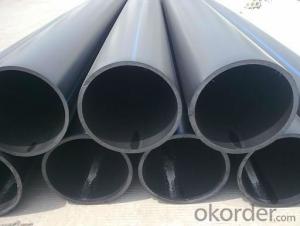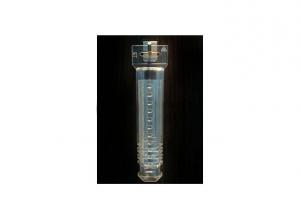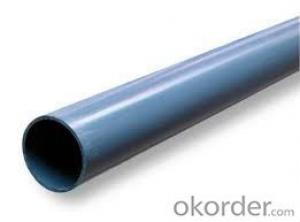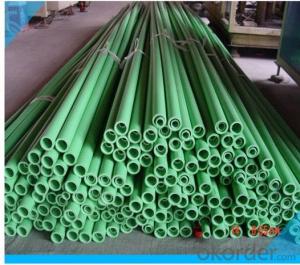Plastic Tubes HDPE Pipe ISO4427-2000 DN50
- Loading Port:
- China Main Port
- Payment Terms:
- TT OR LC
- Min Order Qty:
- -
- Supply Capability:
- -
OKorder Service Pledge
OKorder Financial Service
You Might Also Like
Physical properties[edit]
Polyethylene is a thermoplasticpolymer consisting of long hydrocarbon chains. Depending on the crystallinity and molecular weight, a melting point and glass transition may or may not be observable. The temperature at which these occur varies strongly with the type of polyethylene. For common commercial grades of medium- and high-density polyethylene the melting point is typically in the range 120 to 180 °C (248 to 356 °F). The melting point for average, commercial, low-density polyethylene is typically 105 to 115 °C (221 to 239 °F).it is transprant.
Chemical properties[edit]
Most LDPE, MDPE and HDPE grades have excellent chemical resistance, meaning that it is not attacked by strong acids or strong bases. It is also resistant to gentle oxidants and reducing agents. Polyethylene burns slowly with a blue flame having a yellow tip and gives off an odour of paraffin. The material continues burning on removal of the flame source and produces a drip.[3] Crystalline samples do not dissolve at room temperature. Polyethylene (other than cross-linked polyethylene) usually can be dissolved at elevated temperatures in aromatic hydrocarbons such as toluene or xylene, or in chlorinated solvents such as trichloroethane or trichlorobenzene.[4]
GB/T13663-2000:
| PE63管材规格 | |||||
| 公称 外径dn,mm | SDR33 | SDR26 | SDR17.6 | SDR13.6 | SDR11 |
| 公称压力 PN,Mpa | |||||
| 0.32 | 0.4 | 0.6 | 0.8 | 1.0 | |
| 公称 壁厚 | 公称 壁厚 | 公称 壁厚 | 公称 壁厚 | 公称 壁厚 | |
| 16 | 2.3 | ||||
| 20 | 2.3 | 2.3 | |||
| 25 | 2.3 | 2.3 | 2.3 | ||
| 32 | 2.3 | 2.4 | 2.9 | ||
| 40 | 2.3 | 2.3 | 3.0 | 3.7 | |
| 50 | 2.3 | 2.9 | 3.7 | 4.6 | |
| 63 | 2.3 | 2.5 | 3.6 | 4.7 | 5.8 |
| 75 | 2.3 | 2.9 | 4.3 | 5.6 | 6.8 |
| 90 | 2.8 | 3.5 | 5.1 | 6.7 | 8.2 |
| 110 | 3.4 | 4.2 | 6.3 | 8.1 | 10.0 |
| 125 | 3.9 | 4.8 | 7.1 | 9.2 | 11.4 |
| 140 | 4.3 | 5.4 | 8.0 | 10.3 | 12.7 |
| 160 | 4.9 | 6.2 | 9.1 | 11.8 | 14.6 |
| 180 | 5.5 | 6.9 | 10.2 | 13.3 | 16.4 |
| 200 | 6.2 | 7.7 | 11.4 | 14.7 | 18.2 |
| 225 | 6.9 | 8.6 | 12.8 | 16.6 | 20.5 |
| 250 | 7.7 | 9.6 | 14.2 | 18.4 | 22.7 |
| 280 | 8.6 | 10.7 | 15.9 | 20.6 | 25.4 |
| 315 | 9.7 | 12.1 | 17.9 | 23.2 | 28.6 |
| 355 | 10.9 | 13.6 | 20.1 | 26.1 | 32.2 |
| 400 | 12.3 | 15.3 | 22.7 | 29.4 | 36.3 |
| 450 | 13.8 | 17.2 | 25.5 | 33.1 | 40.9 |
| 500 | 15.3 | 19.1 | 28.3 | 36.8 | 45.4 |
| 560 | 17.2 | 21.4 | 31.7 | 41.2 | 50.8 |
| 630 | 19.3 | 24.1 | 35.7 | 46.3 | 57.2 |
- Q: How do you dispose of plastic tubes responsibly?
- To dispose of plastic tubes responsibly, it is recommended to check if the tubes can be recycled. If they are not recyclable, they should be placed in the general waste bin. However, it is important to minimize plastic waste whenever possible by opting for reusable or eco-friendly alternatives.
- Q: i connected a plastic tube about 7 or 8 inchs long onto a butane can im wondering if when i push down on the can and put a match near it can the fire go back into the can explode
- Yes it will unless you have a regulator between the valve and the tube
- Q: My friend and I got these at the zoo once. We saw them at Candyworld and Schlitterbahn too. They are plastic, refillable tubes that you hold up to a dispenser. The candy is like what's inside a Pixie Stix. You pick the flavor/color. What are these called? We are trying to Google them. Thanks!
- for sure they're no longer reliable for you. they could nicely be better helpful for you even with the indisputable fact that, reasonably. even even with the indisputable fact that, there is further and extra study showing that the guy made sweeteners utilized in fat loose meals are extremely operating against their purpose. Sugar is changed into carbs evidently by using the body, so after we use a man made sweetener the body THINKS it truly is getting those carbs, yet at the same time as it would not-you ultimately end up yearning better sugar! So it ability we only desire to coach self administration no count number which sweet we ensure.
- Q: Are plastic tubes resistant to UV light?
- Yes, plastic tubes can be resistant to UV light depending on their composition and manufacturing process. Some plastic materials, such as PVC or acrylic, can be inherently UV resistant, while others may require the addition of UV stabilizers during production to enhance their resistance. It is important to check the specific type of plastic tube and its intended use to determine its level of UV resistance.
- Q: My two young female gerbils are chewing on the CritterTrail plastic tubes I have connected to the cages. They have tons of chew toys, food, and space. I've placed two toilet paper holders in their large nest area. It's helped a little, but they still chew on the plastic tubes. Which is VERY noisy, and I don't think chewing on plastic is good for them compared to natural wood.
- You would just be better off getting a 20 gallon long tank or a bin cage. The cage you have now is too small and it would be hard to safely connect it to a tank.
- Q: i saw that history of middle ear surgery is a disqualifying factor. will they check records from when i was a toddler?
- That really shouldn't keep you out. But even then, you might be able to get a waiver, they grant them sometimes
- Q: Are plastic tubes resistant to extreme weather conditions?
- Yes, plastic tubes are generally resistant to extreme weather conditions. They are designed to withstand a wide range of temperatures, from freezing cold to scorching heat, without cracking or deforming. Additionally, plastic tubes are typically UV-resistant, which means they can withstand prolonged exposure to sunlight without deteriorating. However, the specific resilience of a plastic tube may vary depending on its composition and quality.
- Q: Are plastic tubes suitable for hydrostatic pressure testing?
- Yes, plastic tubes are suitable for hydrostatic pressure testing.
- Q: replacing fuel filler neck with jy replace it has 2 smaller tubes that change to plastic that are cut off 3
- my answer is try to check it out on auto repair shop..dude
- Q: what do you call the plastic tubes used for pet water bottles, and where can you find them?
- rubber tubes? you can find them at any pet supply store.
Send your message to us
Plastic Tubes HDPE Pipe ISO4427-2000 DN50
- Loading Port:
- China Main Port
- Payment Terms:
- TT OR LC
- Min Order Qty:
- -
- Supply Capability:
- -
OKorder Service Pledge
OKorder Financial Service
Similar products
Hot products
Hot Searches
Related keywords
